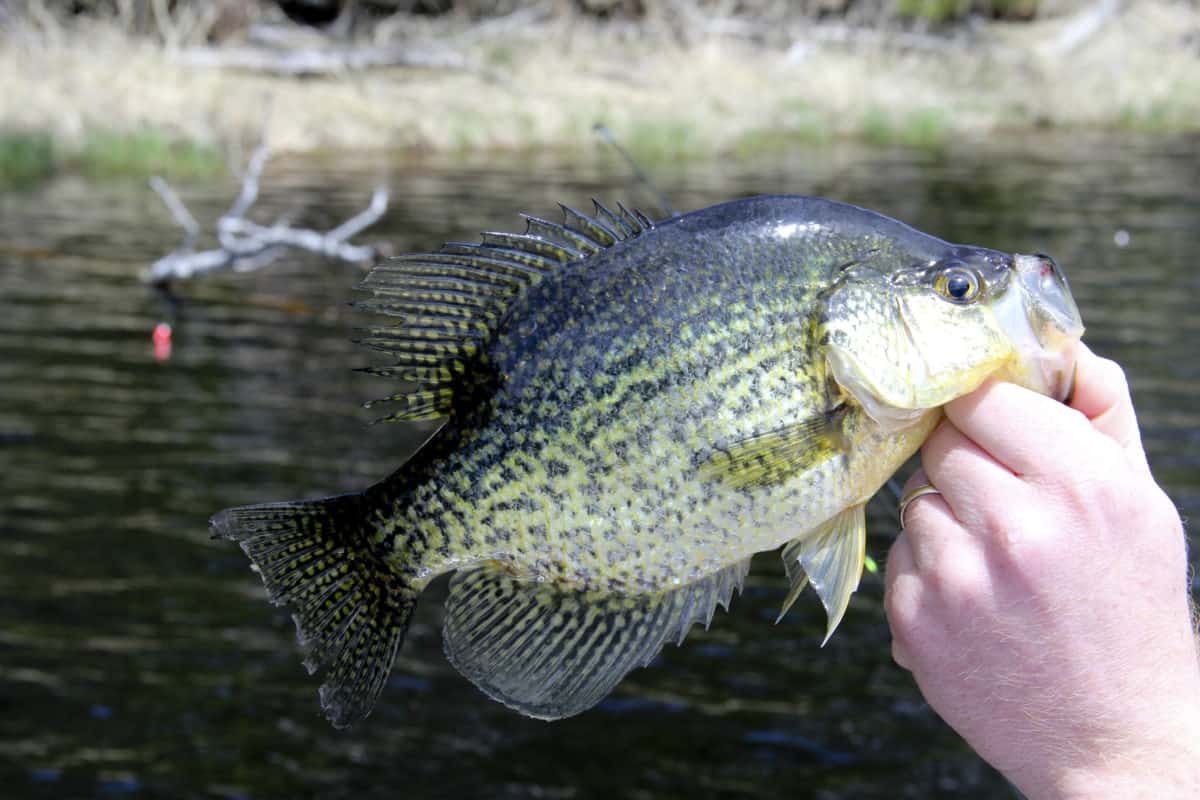Since its debut, this product has divided anglers into two camps: those who believe fish cannot see it or simply do not mind, and those who believe it deters fish from taking their bait.
Ask almost any authority in the crappie fishing realm and you are bound to receive the same answer: Properly rigged Hi-Vis line will not frighten crappie away from striking your lure or bait. Better yet, it will likely increase your success rate on the water.
Most anglers prefer a 2 lbs. to 10 lbs. monofilament line for crappie fishing. Crappie have extremely delicate mouths, and anglers must take great care to avoid ripping their hook out of the crappie’s mouth completely when both fighting the fish and setting the hook.
Monofilament line has a noticeable amount of stretch to it, magnified by the amount of line that you have out. Braided line, while having an excellent diameter to strength ratio, has almost no stretch, meaning almost all the energy transfers to the crappie’s mouth during the hookset.
This may be just fine for other species of fish but is a significant negative when it comes to crappie fishing.
Monofilament fishing line is extruded from a polymer blend and then wound onto the plastic spools for packaging. For Hi-Vis line a brightly colored dye is added to the polymer blend. The color of this dye varies but is typically a bright yellow or orange.
Types of Hi-Vis Line
Mr. Crappie
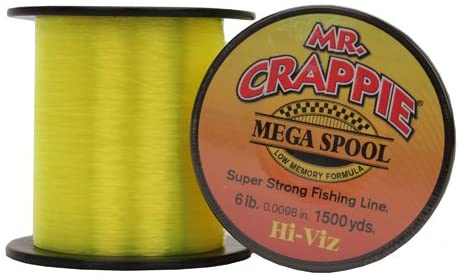
Mr. Crappie manufactures Hi-Vis monofilament line in several tensile strengths, including 4lb to 8lb test. For comparison purposes, this line is produced with a 0.008” line diameter at 4 lbs. test.
Endorsed by the world-renowned crappie fisherman Wally Marshall, many anglers swear by this line and its ability to detect bites.
Stren
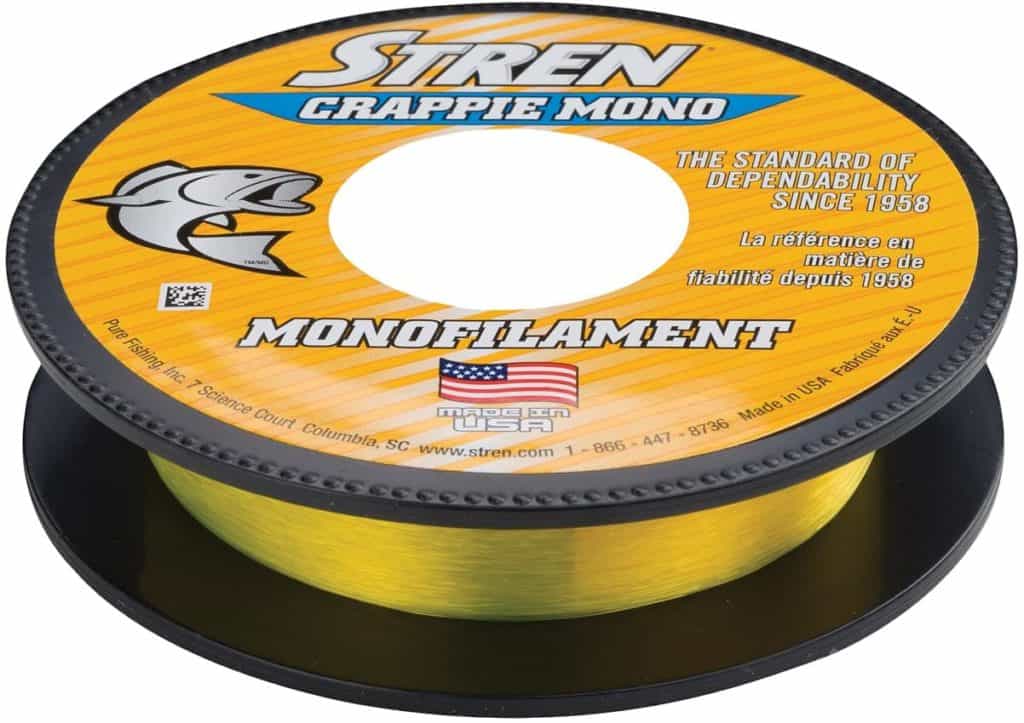
Stren produces a monofilament fishing line specifically branded for crappie fisherman, their Stren Crappie Mono in Hi-Vis Gold. This line is advertised as being optimized for crappie fishing, with superb abrasion resistance for fishing typical brushy crappie hideouts.
This line is offered in 2 lbs. to 6 lbs. test, with a line diameter of 0.007” at 4 lbs. test.
Bass Pro
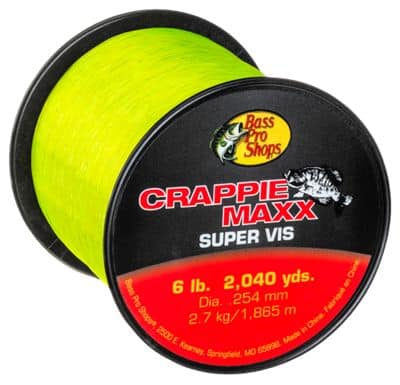
Bass Pro Shops also carries a hi-vis crappie line, known as their Crappie Maxx Super Vis Fishing Line. This line, similar to the others mentioned above, boasts a bright yellow/green color monofilament fishing line, with a great diameter to tensile strength ratio.
Available in tensile strengths from 4lb to 10lb, this fishing line is offered with a line diameter of 0.008” at 4lb test.
Most of these lines have remarkably similar traits, and it comes down to personal preference. It is important to have absolute confidence in whatever gear you decide to use.
Can Crappie See Hi-Vis Line?
There is great controversy in the fishing world regarding whether crappie can see Hi-Vis fishing line. I am sure we have all heard anecdotes from our fishing buddies who adamantly swear against using hi-vis line.
They may have tested the line, but with variables such as lure/bait choice, water clarity, temperature, and more, it can be difficult to produce concrete evidence that crappies are indeed shying away due to the hi-vis line.
Without scientific controlled experiments being conducted on the matter, there is one thing we can do. We can look to experts such as professional tournament crappie anglers and crappie guides.
The next time you find yourself around a crappie tournament, take notice of the angler’s reels, and I can almost guarantee you will find most of them spooled with Hi-Vis line.
With this information, we can draw the conclusion that either one of two things is certain: Crappie cannot see or don’t mind the Hi-Vis line, or the increased benefit of detecting strikes outperforms the decrease in strikes from fish shying away from the bait.
Between work and family, I usually will only have a few days a year to make it afield crappie fishing, and I am looking to maximize the number of fish I can put in the boat.
Wind can both help and hurt an angler depending on other conditions. Hi-Vis line is easy to spot on the water’s surface when the wind is making the water a maze of ripples.
When fishing leeches for early-spring sluggish crappies, I find myself working the bait slowly along the bottom. I usually focus on typical crappie areas, such as submerged brush and other structures.
As the bait slowly falls to the bottom, I can detect the very second a crappie grabs the bait. The Hi-Vis line sticks out like a sore thumb.
A strong argument can be made that the Hi-Vis fishing line actually attracts fish. The line may catch the crappie’s attention initially, but the tantalizing bait will be much more attractive.
If you are still skeptical of using hi-vis fishing line despite its many benefits, there is a way to still get the best of both worlds.
Anglers will sometimes utilize a 2 to 4 feet long fluorocarbon leader when fishing with Hi-Vis as their main line. The fluorocarbon in front of the lure/bait is nearly invisible, while the main line still allows the angler to pick up on the slightest bite.
Can other fish see Hi-Vis line?
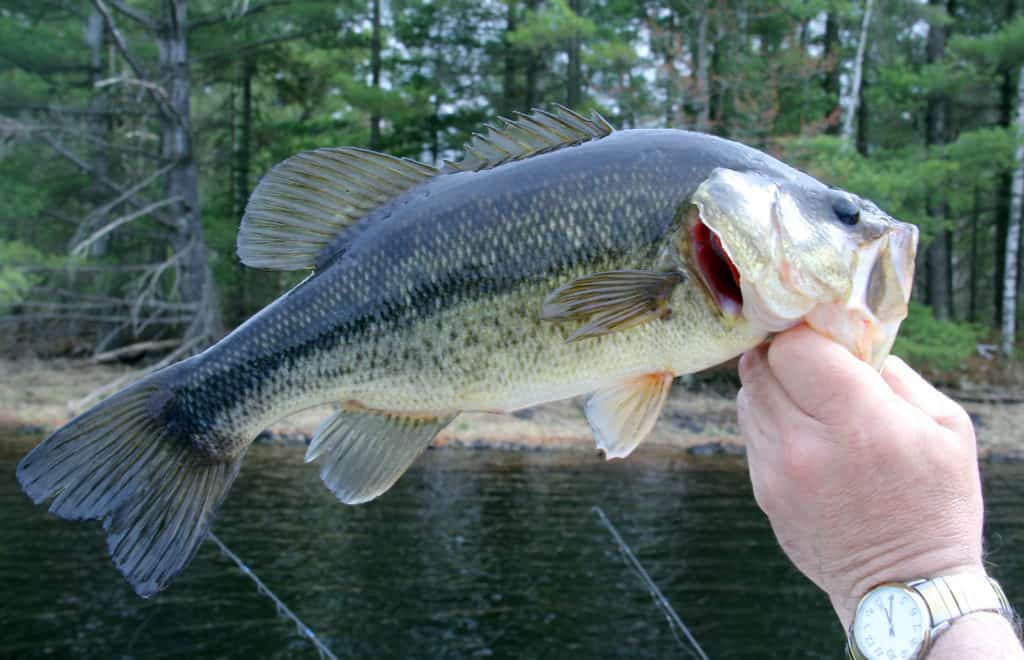
The magic of Hi-Vis line is not limited to crappie fishing. Many bass anglers swear by hi-vis line as well, especially when using finesse fishing tactics when bites may be barely noticeable.
Just recently I was able to appreciate the effectiveness of hi-vis line when fishing for tight-lipped river smallmouth. I was slowly working deep pools of water with a tube jig, pausing occasionally to let the bait sink to the bottom. When the line would make sudden twitches, I knew a fish was picking it up.
I have also found great success in fishing for channel catfish with Hi-Vis line. If the moon is bright enough, you will likely not even need a light to check your lines when bottom-fishing.
Devoted catfish anglers will oftentimes utilize bells or line alarms to alert them when a catfish is running with a bait. Hi-vis line can be used in conjunction with these options, or even be used alone for a budget-friendly option.
Other favorite line colors of crappie fishermen include clear, moss, or other dark colors. The idea is to camouflage the line so that the crappie have difficulty seeing it, and the presentation is natural.
However, I would argue that for every fish that shies away from hi-vis line, several more fish are missed due to almost invisible light hits using clear/dark line.
Crappie tend to bite best during the time immediately following sunrise and the time just before sunset. I have always been grateful for my hi-vis line during these times, and I feel confident in saying I would miss many more fish if I were to use a dark or clear line.
Conclusion
Most anglers I know are willing to do almost anything in order to boat more crappies. Whether you are catching them for tournaments, table fare, or just for fun, I can guarantee you will catch more fish utilizing Hi-Vis line.
For the skeptics, I challenge you to spool up your favorite crappie reel with some Hi-Vis, and at the very least you can use a fluorocarbon leader. This setup will yield the main benefit of this line, while still allowing for a subtle presentation.

